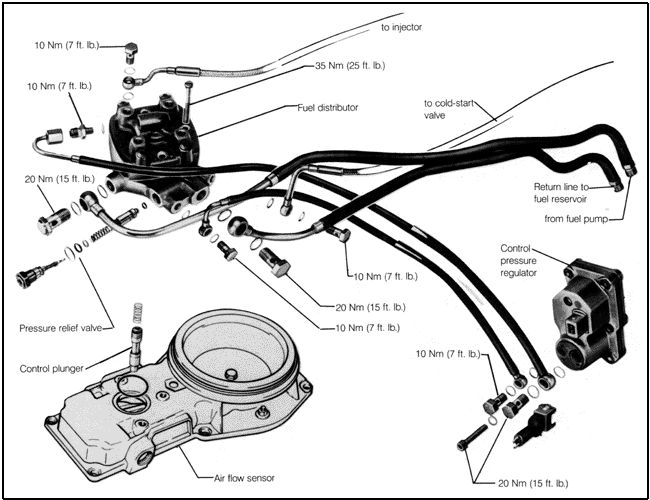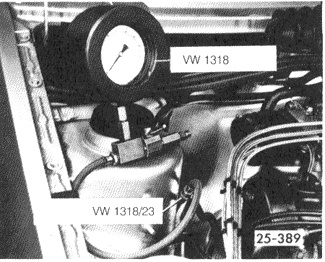Residual PressureThe closed fuel system is designed to maintain pressure after the engine is shut off to help prevent the fuel in the injector lines from overheating, causing vapor lock and hard starting. The fuel pump's one-way check valve and the fuel accumulator help maintain this residual pressure. See 4. Fuel Supply. Check residual pressure with the pressure gauge connected as described above for measuring control pressure. When the engine is fully warm (control pressure between 3.4 and 3.8 bar (49 and 55 psi), shut off the engine. Leave the gauge connected.

After ten minutes, the pressure should not have dropped below 2.6 bar (38 psi). If the pressure drops excessively, check for leaks in the fuel lines, the fuel distributor including the pressure relief valve O-rings, the injectors, the cold-start valve, and the oxygen sensor frequency valve. To further isolate the cause, check residual pressure at the fuel supply line from the pump. See Fig. 5-5, shown earlier. Disconnect the gauge from the fuel distributor and the control pressure regulator line, and reconnect that line to the fuel distributor. Connect the pressure gauge as shown in Fig. 5-24.

Run the fuel pump using a fused jumper wire at the fuse/ relay panel, as described in 4.1 Fuses and Relays, until fuel pressure indicated by the gauge reaches 5 bar (78 psi). Then, turn the fuel pump off. Once again, after ten minutes, the pressure should not have dropped below 2.6 bar (38 psi). If the pressure drops excessively and no leaks are found between the fuel pump and the gauge, repeat the test. This time shut off the pump and immediately pinch closed the fuel hose between the tank and the pump. If residual pressure now stays within specifications, the fuel pump check valve is faulty and should be replaced. See 4.3 Fuel Pump. If the residual pressure still drops off too quickly, the fuel accumulator may be faulty. For a quick check, remove the plug from the end of the accumulator. If fuel drips out, then the diaphragm is leaking and the accumulator should be replaced. |